 |
|
||||||||||
|
 |
|
||||||||||
|
|
From the Editor: Communication is now possible over the Internet in text, voice, and video, using freely downloadable software and relatively low-end computers. Accordingly, for the first time in history, language teachers almost anywhere are able to expose students to authentic language and even put them directly in touch, asynchronously or live, in real time, with native speakers of a given target language. Teachers today have an historical opportunity to teach language in the context and purpose for which it was invented: to communicate with others, to express one's ideas and feelings, and to understand and interact with the ideas and feelings of other native speakers of a target language. At the recent 9th EFL Conference: "Integrating EFL Skills: Strategies for The Teacher, Creativity and Assessment" at The American University of Cairo, Egypt, this past January, the Editor of this column gave a plenary address on how technology makes this possible and why this is a desirable outcome. This version of the talk explains how the Internet can best be used to promote language learning, how used in this way it can motivate and inspire students to take greater interest in learning languages, and how teachers can use the medium themselves to further their expertise in facilitating environments which heighten enjoyment in teaching and learning languages. Vance Stevens |
The Skill of Communication: Technology brought to bear on the art of language learning
by Vance Stevens, Lecturer of Computing, Petroleum Institute, Abu Dhabi, UAE
Often we talk about four skills in language teaching, the skills of reading, writing, listening, and speaking. All of these are of course communication skills, but it is possible in teaching any of these to lose sight of the key role that communication plays in the exercise of language skills. That’s why I decided to give my talk the name that I did, the Skill of Communication. Communication is a value, if not an outright skill, that needs to be integrated in activities we design for the other four skills. The urge to communicate is what motivates people to learn languages, both first and second ones. So it follows that if the other skills are taught in a context that promotes communication this should increase the motivation of students to learn the skills. A context that promotes communication must be rich in interactants. Suitable interactants can be hard to find locally in an EFL situation. The Internet can play an important role in helping students to find other speakers of a language to communicate with them. Perhaps more importantly, it can also play an important role in putting teachers in touch with one another to further their professional development. This gives teachers the knowledge and experience to use online tools effectively in helping students practice communication in safe and productive online environments. This the message that I hope you will take from this talk.
It’s quite likely that, once they are exposed to easy access to the Internet, your students might gravitate to the chat, or Instant Messenger, programs. Often their teachers view these as a distraction, and indeed they can be. On the other hand, these programs clearly have potential and appeal to people who want to communicate, and therefore, given appropriate direction, chat can have a useful role in language learning. I hope in this talk to give some insights into what these appropriate directions might be, and indeed here and in my presentations over the next few days, to explain how a community of learners that I have been working with for the past several years has formed on the Internet, and why they have continued to enjoy working together, some for over five years now, since 1998.
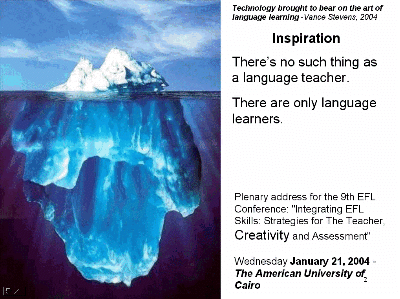 |
The conference theme mentions creativity, and I would like to add another word, inspiration. Both these constructs will prompt communication. Creativity wants to be articulated, and inspiration not only leads to creativity, but can also set the stage for its articulation. That is, you can be inspired to create, and afterwards, if there are people around who might appreciate your creation, you can be inspired, or motivated to communicate with that group about your idea. Inspiration thrives in an atmosphere of reciprocity. For example, I know from experience that it’s hard to play an instrument for audiences, but if the audience is appreciative, you play better and enjoy yourself. I think of teachers as musicians in the classroom. Accordingly, the more your students respond to your guidance, the more your students learn, and the more you are inspired to guide them. |
I said ‘guide’ rather than ‘teach’ on purpose just now. I have a quibble with the concept of teaching. Basically, it’s my contention that there is no such thing as a language teacher, only a language learner. Try envisaging yourself as, not a teacher, but as a learner who has become so adept at learning that you are now qualified to help others to learn.
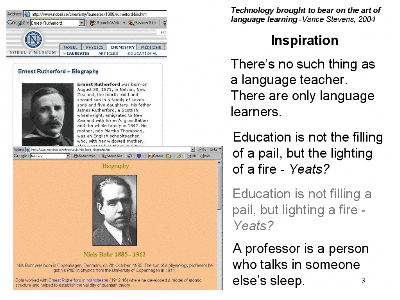 |
This fits well with the idea of teacher as musician. A musician is not on stage to ‘teach’ people in the audience how to play the way he or she does. But a musician might inspire people in the audience to play. The musician can be a guide for others. Just as many famous musicians acknowledge their debt to musicians of previous generations, students also speak of their debt to teachers they have had - but the appreciation is not because the teacher got the student to memorize case endings or finally understand when to use ‘be’ as opposed to ‘does’. To illustrate the point, here are pictures of Ernest Rutherford and his famous student, Nils Bohr. As Yeats once said, or is said to have said, “Education is not the filling of a pail, but the lighting of a fire.” Students appreciate teachers not so much for what they have been taught, as for what they have been inspired to learn. |
Incidentally I did a Google search on that quote to try to find its source, and I found it is so often quoted by others that it has so far been impossible for me to find the original using Internet search tools. I also found this expression “quoted” in various ways in hundreds of sources, “Education is not filling a pail, but lighting a fire,” for example; and not one of hundreds of entries I viewed on the Internet cites the original material. I found that puzzling, and I’m beginning to wonder if Yeats actually wrote, or said that, and if so, where. If you know, please tell me ... (email me at vstevens at emirates.net.ae; and see Note below)
However I did come upon some other interesting quotes about teaching. Socrates apparently said something to the effect that he couldn’t teach anyone anything, he could only make them think. One humorous quote takes the counter approach, “A professor is someone who talks in someone else’s sleep.”
So this idea that teaching is something other than talking in other people’s sleep is nothing new, but paradoxically, it’s an idea of which we as educators need to constantly remind ourselves; that is, to monitor our own use of this term ‘teach’, in order to be sure that what we consider to be teaching is actually creating environments that allow others to learn, more easily said than done.
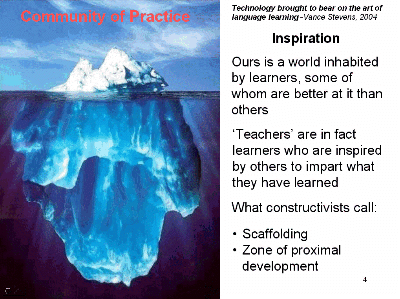 |
Let’s hold those two thoughts here: (1) the idea of ours being a world inhabited by learners, some of whom are better at it than others, and the idea that (2) these super-learners, people who we might think of as ‘teachers’ are in fact learners who are inspired by other learners to impart what they have learned, and who have been inspired by super learners before them to do what is sometimes called ‘teaching’. This is what social constructivists call ‘scaffolding ’ (Bonk and Cunningham, 1998) – and it works when you put learners together in close proximity to one another, in what is called the Zone of Proximal Development or ZPD (Gallagher, n.d.; Ryder, 2002). So although I have the floor here, I really see myself as a learner in a room full of learners. You might say that we share the same Zone of Proximal Development by virtue of being together at a conference, and that we are in a sense scaffolding each other by virtue of attending each other’s presentations. Of course, our Zone of Proximal development exists in a more abstract sense, in that it includes all the people and sets of interactions in our respective networks. |
One way of looking at this is … let’s say this conference is the tip of an iceberg. The small tip, where we are now, is this conference, and the huge iceberg, the reason that the tip is now here, in our field of vision, is our Community of Practice, which is that set of all the people and interactions ‘regarding a particular practice’ in our respective networks. (Snyder, n.d.) So this iceberg coincides with our Zone of Proximal Development, and our scaffolding occurs throughout it and probably with other icebergs as well, or other fields that touch the one we are most concerned with at present, that of Language Learning. (See Healey, 2001 for a cogent characterization of the role of constructivism in language learning.)
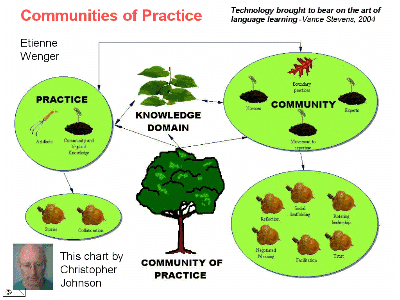 |
I mentioned a community of practice just now, and that’s a concept I’ve grown familiar with myself only in the last year or two. Perhaps the best known proponent of communities of practice, at least the one making the most money off the term, is Etienne Wenger, who has written several books and articles on the subject (e.g. Wenger, 1998). Another researcher in the field is Christopher Johnson, a member of the Webheads in Action community of practice, who is carrying out research on that group as part of his PhD studies (Johnson, 2003c). Chris produced the chart displayed here, and others like it, to describe what communities of practice do and how they operate. Since we share a common ZPD as members of the same online community, and he appears online occasionally on web cam, that’s where this picture of him came from. |
Here you can see that what I have represented in the metaphor of an iceberg, Chris presents as a tree, and the diagram intends to show how novices and experts meet together in the community to develop the expertise of all concerned through negotiating a mutual understanding of the knowledge domain, and its manifestation in practice. Incidentally an expert in one aspect of the knowledge domain may be a novice in another, so scaffolding tends to be a give-and-take proposition. As shown on the chart, other social constructivist principles such as reflection, negotiated meaning, facilitation, and trust are all elements in the process.
Communities of practice may be recognized as such and have names, or they might form spontaneously and have adherents but no recognizable structure. An example of a formally structured community of practice might be a listserv such as NETEACH-L or TESLCA-L (alternate link), or a professional organization such as EgypTESOL. Essentially these groups have in common that they are composed of people who band together to learn and work in unison to improve their expertise in their common interest, or practice.
A community of practice might be much more loosely formed, such as a community of language learners. These could be people anywhere in the world who band together as the opportunity arises to further their interest and expertise in the language that they are trying to master and gain an appreciation for. These social groupings have more loosely defined boundaries and no set memberships, but when their members encounter each other they might work together spontaneously to help each other to further their common practice.
So these are social groupings that we recognize as having certain boundaries, and because they serve to further the common purpose of their members, we can think of them as communities of practice.
Now, let’s say you want to learn a foreign language. How do you go about that? Probably if you have just now decided to learn this language you might go out and buy a book. Or whatever your level of proficiency, you might enroll in a course designed to ‘teach’ you the language. But already you’ve run up against what I claim is an oxymoron. There is no such thing as a language teacher. There are only language learners. That’s you. If you’re lucky, your teacher will understand this and try to steer you in directions that will help you on your way to learning the language. But your teacher can only take you so far on this road, because this road gives only limited access to the surrounding countryside. As a passenger in your teacher’s bus, or car if it’s a private class, you are left to try and learn the language essentially by reading billboards at the side of the road. Through the windows of your vehicle you see native speakers of the language passing. How can you engage them? How do you gain access to the countryside? The key to that I think is to make use of your implicit membership in a community of practice.
This is a road that many have been down in many different vehicles over the centuries. Richard Burton, the famous linguist and traveler (not the actor), learned some 65 languages and dialects by hiring speakers of those languages to accompany him whenever he wanted to learn their language. I wonder what he would have done if he’d had access to Internet and instant messengers with free web cam and voice enabled components. Since he lived in a previous century he had to use different means, but it seems he did very well with what he had, which was, I suspect, relatively unlimited time in the company of native speakers. Nowadays, few of us would have that luxury even if we had the inclination; but in any event, the goal of a successful language learner is the same today as it was in Richard Burton’s day; and that is communication with native speakers through the other skills of being able speak and write to them, and to be able to follow and understand what they say and write.
Fortunately, computer-based access to the Internet is starting to restore that balance. Let’s compare modern-day language learning before, and after, access to native speakers has become possible through the Internet. As someone who has been involved in teaching and learning languages since the mid 1970s, when access to native speakers was often only for those who could afford to travel, I can tell you how teaching was done back then.
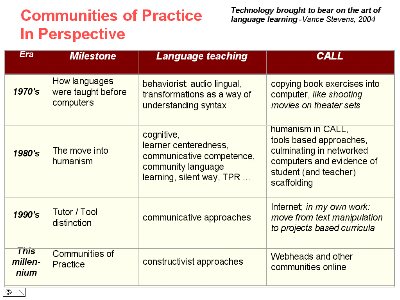 From: http://www.vancestevens.com/papers/tesolarabia2002/outcomes.htm |
Essentially this chart arrays how languages have been taught over the past few decades. Before computers, when the methodology was weighted toward behaviorism, audio lingual was the dominant approach, and teachers taught transformations as a way of understanding syntax. In our early computer work, we copied book exercises into the computer, and Seymour Papert wrote in his book Mindstorms, in the early 80s, that this was like shooting movies on theater sets the way the earliest film makers did, before they learned to exploit angles, effects, and settings unique to the medium. By then there was taking place a move into humanism, more cognitive approaches, and stress on learner centeredness. Communicative competence was the buzz at the time, and Del Hymes was cited in many scholarly papers to be published during this era. Teaching methods such as community language learning, silent way, and total physical response were being echoed in attention to humanism in CALL (Stevens, 1992). Teachers were finding computer-based learning compatible with tools based approaches, with students starting to work in networked environments, where we began to notice evidence of students' scaffolding, or teaching one another - and there was evidence of this in teacher staff rooms as well. |
About this time, people were making the Tutor / Tool distinction with computers (Taylor, 1980). In the classroom, teachers were using more communicative approaches. The Internet had arrived on the scene. In my own work, I saw a move away from text manipulation, which I often used as a means of getting teachers and students quickly into using computers in CALL contexts they could immediately relate to, to projects based curricula once language learners and teachers began to understand more clearly what was unique to the medium. (See Warschauer and Healey, 1998; and Higgins, 1999, for overviews of this era.)
By now we're growing increasingly uncomfortable with using the term CALL to describe what we do. That’s mainly due to association with that old era of activities associated with CALL, not that what we do is not computer-assisted language learning. Nowadays, I see a lot of interaction within communities of practice, with constructivist approaches permeating learning environments, and in my work, this is manifested in the emergence of Webheads and proliferation of other communities of learners and educators working online (see Almeida d'Eça, 2004; Steele, 2002; Sanders, 2002).
|
Here is a quote from an Interview with Seymour Papert where he suggests that the concept of teaching, as we currently know it, may one day vanish. (Bennahum, n.d.) 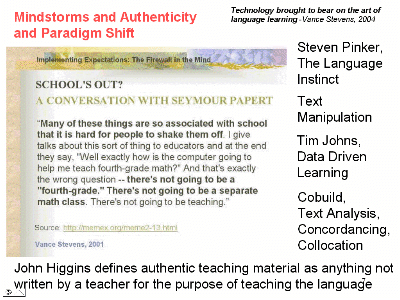 |
In my first ESL teaching jobs, I was expected to use the audio-lingual method when teaching. The books were written that way. Emphasis was on memorization, and repetition of dialogs had teachers standing over the mimeograph machines seeing who could churn out the wittiest inventions of pseudo-natural language. Creation of inauthentic dialog was favored because dialogs could be constructed heavily weighted toward the linguistic forms being taught. This approach was commensurate with avoidance of authentic and natural speech acts in the materials creation processes. The needs of students to genuinely communicate would have been given short shrift in a classroom where an inexperienced teacher dogmatically applied these methods. The result was that language learning was not necessarily fun or particularly meaningful. I don't mean it couldn't be fun -- it was as fun as its practitioners could make it! But practitioners in foreign language contexts simply didn't have the means at their disposal to bring the language to real life – there was only one live interactant, the teacher - and so in the hands of the most assiduous practitioners of these methods, students were having suppressed in them the instinct to express themselves, and teachers could all too easily ‘burn out’ and feel that they and their students had been turned into automatons. |
We now know – or suspect at any rate – that all this was unnecessary. Steven Pinker’s book, The Language Instinct, is one modern, easily accessible book that credits learners with the capacity to figure out the structure of a language through an innate ability to make sense out of what appears to be gibberish, but isn't. (Pinker, 1994) This suggests, to me at any rate, that natural language should be presented to learners from the earliest stages of their training, not withheld from them and replaced with inauthentic materials created by teachers for the purpose of teaching (as opposed to learning) languages.
Authenticity is a key element here: John Higgins has defined authentic teaching material as anything not written by a teacher for the purpose of teaching the language. There’s that word ‘teaching again’. Before computers began opening doors to a world of readily-accessible natural language, teachers tended to avoid confusing the learners with realia, on the assumption that they wouldn’t be able to process it. John Higgins was a proponent of having students get at the meaning of texts through text manipulation programs of his own design. He and Tim Johns were developing the concept of using concordance programs to engage students in what Johns referred to as Data Driven Learning (Johns, 2000). This was at a time when the Cobuild project was re-writing the dictionary through a text analysis approach to listing the actual most commonly used meanings of words first, as opposed to the previously perceived but unsubstantiated so-called most common meanings first.
Despite its great impact on our understanding of collocation and isolated successes in pedagogy, it has never been convincingly shown that text analysis and concordancing can take hold in language learning. Although a powerful tool for researchers and the most analytic of learners, the concept has not been widely understood or embraced by teachers, and hence less so by their students (but see Stevens, 1995; Stevens, 2004a; Ball, 1996; and Tom Cobb's 'compleat' text analysis approach to vocabulary development).
As the last century drew to a close, getting at real authentic language through analysis and manipulation of texts was the best we could do at the time. We didn’t have the Internet but we did have increasing access to authentic texts in electronic form. With the emergence of the Internet as a tool in language learning, the pile of available texts was exponentially increased, and indeed this is what many language teachers saw as the greatest potential of the Internet in language learning - a rich source of authentic text, and nowadays audio and video as well, and for many, this is still the case. And that’s not a bad thing. But there’s more to it than that.
But first, why am I dwelling on the 20th century when we should be focused on the 21st? Consider this: Although the computer has changed how we teach and learn in ways we could hardly have anticipated a few years or even a few months ago, it is important to consider use of technology in the perspective of the mindset of language teachers from these past decades. Many of these teachers were ourselves, or if you are younger, then they were your teachers, and their methodologies have a good chance of being recycled unless we step back and take a close look at the direction we are headed with respect to the tools we now have available to us. It’s important to appreciate and keep in mind what a radical paradigm shift many of us from that era have had to make in order to accommodate computers in our practice and use them appropriately and effectively. (Stevens, 2001)
At first, computers were seen as modern language labs - a way to increase efficiency by increasing the possibilities for drill and practice, or by emulating what might be called the teacher's knowledge base and doling that out to the students. But association of the computer lab with the aural-oral language lab dinosaur has always been spurious. Language labs were designed for little purpose other than to mechanize the audio-lingual method. A computer lab on the other hand contains equipment and components that students can use and relate to in many aspects of their real lives, many of which have now become accepted means of communication themselves. Given these many relationships between computers and how we have come to communicate in a modern world, the most potentially successful paradigms to employ them in language learning today, I believe, involve using them in such a way that they do an end run around the teacher and this concept of teaching itself and put students in direct touch with other target language speakers in authentically communicative situations.
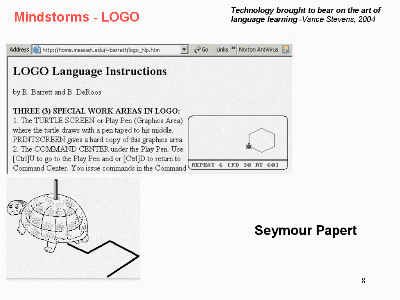 |
In order to think that this might work we have to put some faith in the power of the individual to learn, or to essentially teach him or herself. As corroborated in the book by Pinker just mentioned, there is much evidence that humans have this power, but of special interest to us here are those cases where learners have been able to figure out the language required to work computers (and thus people should be able to figure out how to use computers to do what we already know they can do: figure out how to speak a language). Papert’s work with LOGO demonstrated that kids left alone with an interesting and empowering tool can learn to use it to manipulate the world thus revealed. Papert created a toy turtle that kids could program by writing simple mathematical algorithms that, when applied recursively, caused the turtle to trail a marking pen that made diagrams on sheets of paper laid out on the floor. This has yielded insights not only for training of young mathematicians and programmers, but has contributed to features we take for granted in object-oriented application tools we use on computers every day. |
|
More recently, a similar outcome has been demonstrated in the computer kiosks installed in poor areas of New Delhi, where street children learned to use Internet connected computers simply by approaching them through ‘holes in the wall’ and figuring out what to do. I have a picture here from an article by Mark Warschauer published in Scientific American. Mark mentions many limitations to what the street kids could do with these computers without guidance, but the interesting thing is that they illustrate once again our universally human capacity to resolve a language mutually intelligible to users and programmers communicating through a machine. (Warschauer, 2003) |
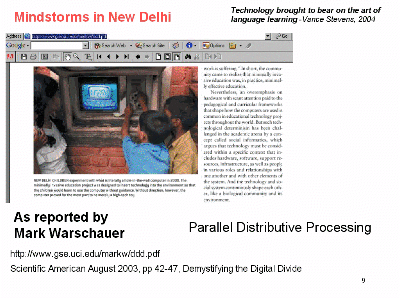 |
I imagine that no one invented the wheel. Probably people in many separate locales happened independently on the discovery that round objects were better at overcoming inertia than flat ones, and it was probably not a huge leap for people to incorporate that realization in the accomplishment of daily mundane tasks. Cognitive science has formalized this phenomenon under the term Parallel Distributive Processing. The concept is that if you are given or shown a powerful tool, you will learn to use that tool to manipulate your surroundings. Rumelhart and McClelland, 1987 have shown how such a model can explain acquisition of certain past tense forms in English, where users of the language make use of feedback loops to resolve doubts in learning how the grammar functions.
The next big breakthrough in technology brought to bear on the skill of communication was the development of the instant messenger, especially the ability to see when others were online. The first of these tools was ICQ, which came into popular use in the mid 90s. ICQ also gave users a set of tools for chatting and sharing files and it was not long before a budding community of language learners discovered the potential of this new medium of communication.
|
The community of language learners is called Writing for Webheads, and it is the one that has been going since 1998. This group eventually attracted the interest and participation of so many language learning professionals that we were noticing a suppression of student input, so in 2002 Webheads in Action was formed as a sort of experiment to see if the community-building techniques that had worked so well with the student group could be replicated with a group of language learning professionals who would be taught the techniques as they experienced first-hand how the community could form and develop (Stevens and Altun, 2002; Stevens, forthcoming). The experiment worked so well that the group continued beyond the time-frame for the original course and into a second round of courses a year later, where it undertook a study of itself as an example of a distributed community of practice. This study culminated in a symposium at the TESOL convention in Baltimore last year (Stevens et al., 2003) where, because of the world situation at the time -- the outbreak of SARS coupled with the start of the Iraq war -- only half our panelists were able to travel to be in attendance. So we arranged to have a phone line installed in the room where our panel would meet and we beamed in the missing presenters using voice chat software, and broadcast our session to the world at large while were at it. |
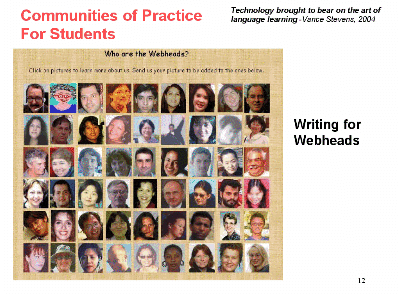 |
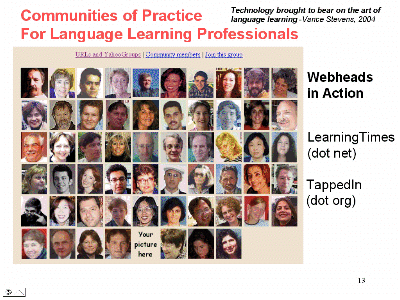 |
Although we had to pay convention prices for the phone line in Baltimore, we have often broadcast from conferences, usually for free (Internet connection is normally provided at such conferences). The software to do this is freely downloadable, and all you need really is a reliable Internet connection. Last month, we reversed the process and I presented to an audience in Cairo from my home in Abu Dhabi (Stevens, 2003), using voice enabled chat software at the website of Learning Times <http://www.learningtimes.org>. To use the software you have to register with the community, but it’s a community of educators, and its use is free. Another online community portal which our Webheads communities use regularly and which I also recommend to educators is Tapped In <http://www.tappedin.org>. It would be well worth your while to point your browsers to these two web sites, if you are interested in pursuing this topic. |
At the moment my focus with these two groups is on the teacher training aspects. I think that in order for these techniques to be used with students, it is necessary first that you, their teachers, become comfortable with the media involved. Admittedly there is so much that can go wrong with connectivity, with the software, with firewalls, that it is understandable that teachers prefer to stick with what they know when meeting with students. We (Webheads) are working within our community to scaffold one another into a greater understanding of these tools. Our approach is working. Many of our members have engaged their students in gratifying projects which they say they could not have accomplished if not for their work with Webheads in Action.
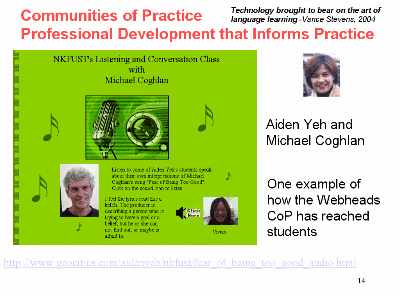 |
I could produce dozens of stories of such accomplishments but I’ll note just a couple. Here is a PowerPoint slide showing a portal developed by Aiden Yeh (n.d.), who collaborated with Michael Coghlan, another Webheads community member who, to bring us back to one of the themes at the beginning of this talk, is a musician and teacher who writes his own music and puts it online at his web site for use with his own students in Australia. Aiden had her students in Taiwan listen to one of the songs and then meet with Michael online to discuss it, and then Aiden documented her students’ reactions and interactions with Michael on her own web site. |

Another success story is that of Yaodong Chen, a longtime collaborator with Webheads from Liuzhou, China. Yaodong has made the faces of the students in his packed face-to-face classrooms familiar to Webheads, and his constant efforts to bring them "out of the fishbowl" (as one of our online collaborators, Shunichiro Ito, has put it) and put them in touch with a world of native speakers have paid off. His use of CMC tools in his one-computer classrooms eventually resulted in his being granted a much larger CALL facility. I documented his work with Webheads in my first article as Internet editor for TESL-EJ (Stevens, 2002).
|
Yet another success case is that of Buthaina Alothman at Kuwait University. Buthaina joined Webheads in Action when it was formed in 2002. She used the community in the way that Chris Johnson describes in his diagram to increase her expertise in online communications tools to the point where she had developed a ‘before and after’ website -- where she showed us examples of her web design before and after exposure to Webheads -- and she said she was, in her words, “much obliged” to the help Webheads had given her in facilitating her professional development (Alothman, 2003). She joined us as a contributor in our recent online workshop (where we examined our own community as an example of a distributed community of practice) in the part where members discussed how what they had learned with Webheads in Action informed their teaching practices. |
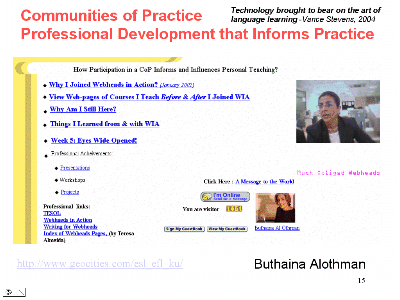 |
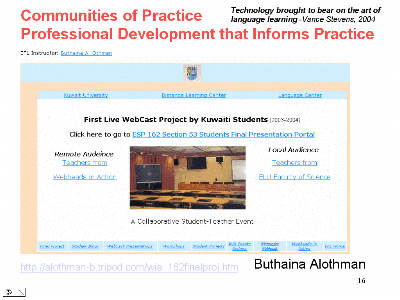 Buthaina also took pictures of the first ever meeting face-to-face of the three Webheads collaborators Stevens, Coghlan, and Alothman, and she has posted these pictures here: http://alothman-b.tripod.com/wia-buth-gld.htm: |
Late last year Michael Coghlan paid a visit to me in Abu Dhabi, our first-ever face-to-face meeting in over 6 years of online collaboration. He came at a time when Webheads were giving a Global Learn Day presentation via voice chat live and online from an auditorium at Petroleum Institute in Abu Dhabi. Although there were but half a dozen people in the live auditorium audience, there were ten times that many in the virtual voice chat audience from all over the world. Because she lived nearby in Kuwait, Buthaina, whom we had also never before met face-to-face, hopped on a plane and joined Michael and I on stage in Abu Dhabi. The experience was revealing to her. As she said later, she saw how things worked from behind the curtains. It’s not rocket science, and I’ll try to show more about how it’s done in a demonstration I’m giving on Friday (Stevens, 2004b), but sometimes it’s good to see first-hand how simple it all really is. Buth’s reaction was clearly, “Oh, I can do that myself,” and so when it came time for her students in Kuwait to make their end-of-term presentations, she constructed the activity according to what she had learned. She lined up an auditorium with an Internet connection and networked with Webheads to ensure the presence of a virtual audience, and her students presented not intramurally within the confines of their classroom at Kuwait University, but to a world at large. |
|
I ask you to ponder for a moment how motivating, real, and meaningful that experience must have been for her students. Buth has helpfully documented her work online so you can visit her web site and see feedback from her students and others who participated in those student presentations online (Alothman, 2004). How do students benefit from these activities? One of the first studies of chat in the sort of contexts I’m describing was done by Jo Mynard (2002a and 2002b), a colleague in the UAE, as part of her doctoral dissertation. She lists several benefits as given on the slide shown here. These include interaction in authentic contexts with native speakers, promotion of learner autonomy, improvement of interactive competence, and opportunities to 'notice' language used by native speakers. |
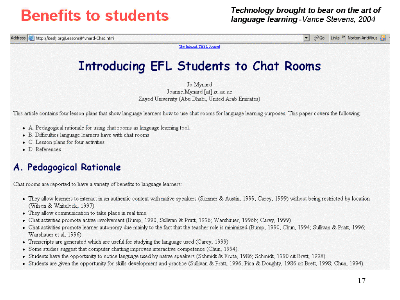 |
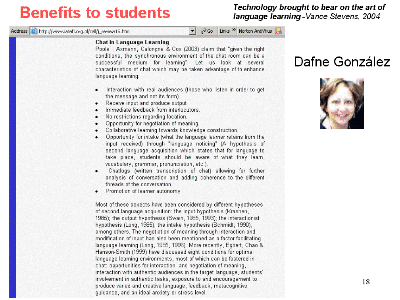 |
Another article on this topic has been produced by Dafne González (2003), another member of the Webheads in Action community. Both articles list benefits to students compatible with constructivist principles: learner autonomy, negotiation of meaning, immediacy of feedback, and a further benefit of having a record of the chat for enhanced study later. This is possible for both voice and text chats by the way. Dafne also references the work of Joy Egbert, who couches benefits from use of technology, including synchronous chat, in terms of TESOL and other written standards (e.g. Egbert 2000, and mentioned in Egbert 2001, two give two examples accessible online). Another published article on the benefits of chat is one by Webheads community member Teresa Almeida d'Eça, who characterizes chat as "a powerful and effective communication tool that fosters a fascinating, authentic and enriching learning experience." (Almeida d'Eça, 2003) |
Conclusion
To all too briefly encapsulate six years of development and evolution of this community, here are some things we have learned.
We have learned that it’s possible to bring people together to work on a common purpose or practice via the Internet, but the recipe requires several essential ingredients:
I am often asked what we do in such an environment. I often answer that it’s like Seinfeld. Do you know Seinfeld, the American comedy TV show? It’s a show about nothing. We talk about nothing, and about everything: the weather, local concerns, our lives and surprisingly personal details (considering we are mostly strangers), and of course, we talk about our practice, language learning. Because it’s informal, we talk, and we learn from one another.
In the case of Computer Mediated Communication, the practice IS the medium. That is, the goal is to learn about a language if you’re a student, or about how to facilitate language learning through CMC tools if you’re a teacher, or perhaps both for either group (because not all our teachers are native speakers of English, and a lot of our NNS students who aren’t teachers are interested in CMC out of interest or as an aspect of their professions). So a part of our discourse is about using the tools, troubleshooting problems, and finding new tools. Topics are not restricted to tool talk, but as the community grows and percolates through its new members, the likelihood of gaining insights from the interaction grows too. As with any stimulating endeavor, it’s hard to pinpoint what someone is getting from it at a given moment. But one indication that it’s beneficial, at least in Webheads, is that people keep coming back to it, week after week, year after year. And it cuts to the core of that overriding reason to learn a language: to communicate. It’s constructivist: people talk about what they want to talk about, each person is in control to the extent he or she wants to be, the affective filter is way down, meaning derives from within, and scaffolding clearly takes place within the zone of proximal development that encompasses the community of practice.
References
Almeida d'Eça, T. (2003). The Use of Chat in EFL/ESL. In TESL-EJ Vol. 7. No. 1, June 2003. Retrieved February 23, 2004 from: http://www-writing.berkeley.edu/TESL-EJ/ej25/int.html
Almeida d'Eça, T. (2004). Webheads in Action (WiA): An online community for professional development – from past to present. Humanising Language Teaching, Vol. 6, No. 1. Retrieved February 13, 2004 from: http://www.hltmag.co.uk/jan04/sart10.htm
Alothman, Buthaina. (2003). How participation in a CoP informs and influences personal teaching. Retrieved February 17, 2004 from http://www.geocities.com/esl_efl_ku/
Alothman, Buthaina. (2004). First live webcast of project by students (2003-2004). Retrieved February 17, 2004 from: http://alothman-b.tripod.com/wia_162finalproj.htm
Ball, Catherine N. (1996). Tutorial Notes: Concordances and Corpora (Georgetown University). Retrieved February 21, 2004 from: http://www.georgetown.edu/cball/corpora/tutorial.html
Bennahum, D. (n.d.). School's out? A conversation with Seymour Papert. MEME 2, 13. Retrieved February 15, 2004 from http://memex.org/meme2-13.html
Bonk, C. and Cunningham, D. (1998). Searching for learner-centered, constructivist, and sociocultural components of collaborative educational learning tools. In C. Bonk & K. King (Eds.), Electronic Collaborators: Learner-centered technologies for literacy, apprenticeship, and discourse (pp. 25-50). Mahwah, NJ: Lawrence Erlbaum Associates. Retrieved February 15, 2004, from: http://www.publicationshare.com/docs/Bon02.pdf
Cobb, T. (n.d.). The Compleat Lexical Tutor: For data-driven learning on the web. Retrieved February 21, 2004 from: http://132.208.224.131/
Coghlan, M. Welcome to Michael Coghlan's website. Retrieved February 17, 2004 from: http://users.chariot.net.au/~michaelc/
Egbert, J. (2000). T&L 472 Technology for Language Learning. Retrieved February 17, 2004 from: http://www.wsu.edu/~egbert/472/472syl.html
Egbert, J. (2001). Active learning through computer-enhanced activities. Teaching English with Technology Vol. 1, Issue 3 (May 2001). Retrieved February 17, 2004 from: http://www.iatefl.org.pl/sig/call/j_article3.htm
Gallagher, C. (n.d.). Lev Semyonovich Vygotsky (1896 - 1934): Biography, Theory, Time Line, Bibliography. Retrieved February 15, 2004, from: http://fates.cns.muskingum.edu/~psych/psycweb/history/vygotsky.htm
González, D. (2003). Teaching and learning through chat: A taxonomy of educational chat for EFL/ESL. Teaching English with Technology, Vol. 3, No. 4 (October 2003). Retrieved February 17, 2004 from http://www.iatefl.org.pl/call/j_review15.htm
Healey, D. (2001). Are Technology-Using Students Better Learners? Article form of presentation webcast at the Teacher to Teacher Conference: The Process of Language Learning, held in Abu Dhabi November 6-7, 2001. Retrieved February 15, 2004, from: http://oregonstate.edu/~healeyd/t2t.html
Higgins, J. (1999). Classification of CALL activities. Retrieved February 15, 2004 from http://www.celt.stir.ac.uk/call99/CALclass.html
Hymes, D. (1970). On communicative competence. In J. J. Gumperz and D. Hymes (eds), Directions in Sociolinguistics. New York: Holt, Rinehart and Winston.
Johns, T. (2000). Tim Johns Data-driven Learning Page. Retrieved February 15, 2004 from http://web.bham.ac.uk/johnstf/timconc.htm
Johnson, C. (2003a). CoP Theory Overview. Retrieved February 15, 2004, from: http://sites.inka.de/manzanita/cop/
Johnson, C. (2003b). Annotated Bibliography: Web version. Communties of practice bibliography created for Webheads in Action EVOnline sessions. Retrieved February 15, 2004, from: http://sites.inka.de/manzanita/dissertation/biblio_COP.htm
Johnson, C. (2003c). Establishing an Online Community of Practice for Instructors of English as a Foreign Language: A formal proposal submitted in partial fulfillment of the requirement of Doctor of Philosophy Graduate School of Computer and Information Sciences Nova Southeastern University. Retrieved February 20, 2004 from: http://sites.inka.de/manzanita/dissertation/formal_proposal_1.1.htm#_Toc33290524. Keep an eye out for the Final Report (dissertation) at this link: http://www.scis.nova.edu/~johnschr/ .
Mynard, J. (2002a). Introducing EFL Students to Chat Rooms. The Internet TESL Journal, Vol. VIII, No. 2, February 2002. Retrieved February 17, 2004 from http://iteslj.org/Lessons/Mynard-Chat.html
Mynard, J. (2002b). Making Chat Activities with Native Speakers Meaningful for EFL Learners. The Internet TESL Journal, Vol. VIII, No. 3, March 2002. Retrieved February 17, 2004 from http://iteslj.org/Techniques/Mynard-Chat2/
Papert, S. (1980). Mindstorms: children, computers and powerful ideas. Brighton, The Harvester Press. 230 pp. ISBN 0-85527-163-9.
Pinker, S. (1994). The language instinct: How the mind creates language. Harper Perennial (Harper/Collins Publishers).
Rumelhart, D. and J.. McClelland. (1987). Learning the past tenses of english verbs: Implicit rules of parallel distributed processing. In B. MacWhinney, editor, Mechanisms of Language Aquisition, chapter 7, pages 197-248. Lawrence Erlenbaum Associates, Hillsdale, New Jersey.
Ryder, M. (2002). Constructivism (University of Colorado at Denver, School of Education. Retrieved February 15, 2004, from: http://carbon.cudenver.edu/~mryder/itc_data/constructivism.html
Sanders, D. (2002). EFI - English Language for Internet with Webheads. In Learning from the innovators: Internet Communication Technologies Changing Business Practices, Issue two (2/3) ICT’s in different cultural contexts: 29 August, 2002. Retrieved February 15, 2004, from: http://www.imakenews.com/ict1/e_article000089866.cfm?x=193008,0
Snyder, E. (n.d.). CoPs (Communities of practice). tcm.com inc. Training and Development Community Center. Retrieved February 15, 2004, from: http://www.tcm.com/trdev/cops.htm
Steele, J. (2002). Herding cats: A descriptive case study of a virtual language learning community. Dissertation submitted to the Graduate School and Research, Indiana University of Pennsylvania, in partial fulfillment of the requirements for the degree of Doctor of Philosophy in English. Retrieved February 15, 2004, from: http://netdial.caribe.net/~jhsteele/catstoc.html
Stevens, V. (1992). Humanism and CALL: A coming of age. In Pennington, Martha, and Vance Stevens (Eds.). Computers in applied linguistics: An international perspective. Clevedon, England: Multilingual Matters, pp. 11-38. Retrieved February 15, 2004, from: http://lightning.prohosting.com/~vstevens/papers/1991_humanism/humanism91.htm
Stevens, V. (1995). Concordancing with language learners: Why? When? What? CAELL Journal 6, 2:2-10. . Retrieved February 21, 2004, from: http://www.ruf.rice.edu/~barlow/stevens.html
Stevens, V. (2001). Implementing Expectations: The Firewall in the Mind. Plenary Address delivered at the 'Implementing Call in EFL: Living up to Expectations' conference at the University of Cyprus, Nicosia May 5th - 6th, 2001. Retrieved February 22, 2004 from: http://www.vancestevens.com/papers/cyprus2001/plenary/index.html
Stevens, V. and Altun, A. (2002). The Webheads community of language learners online. In Syed, Z. (Ed.). The process of language learning: An EFL perspective. Abu Dhabi: The Military Language Institute. pp. 285-318.. Pre-publication draft retrieved February 15, 2004, from: http://www.homestead.com/prosites-vstevens/files/efi/papers/t2t2001/proceeds.htm
Stevens, V. 2002. A day in the life of an online language educator. TESL-EJ 6, 3. Retrieved February 17, 2004 from: http://www-writing.berkeley.edu/TESL-EJ/ej23/int.html
Stevens, V. (2003). Teacher professional development in online communities of practice: How does this impact language learning? An online presentation made December 18, 2003 webcast to the CALL (Computer-Assisted Language Learning) Symposium, Cairo, Egypt. Retrieved February 13, 2004 from: http://www.vancestevens.com/papers/egypt/tpd_online.htm
Stevens, V., Jones, C., Almeida d'Eça, T., Freed, A., Alothman, B., Yeh, A., González, D., and Coghlan, M. (2003). Case study of a community of practice. Colloquium presented March 26, 2003 at the TESOL 2003 Convention, Baltimore, Maryland, USA. Retrieved February 23, 2004 from: http://www.vancestevens.com/papers/tesol/baltimore2003/copractice.html#colloquium
Stevens, V. (2004a). Text Analysis: Concordance and Collocation. Retrieved February 21, 2004 from: http://www.vancestevens.com/textanal.htm
Stevens, V. (2004b). Online tools for creating communities of communicative learners. Presentation given January 23 at the 9th EFL Conference: "Integrating EFL Skills: Strategies for The Teacher, Creativity and Assessment" at The American University of Cairo, Egypt. Retrieved February 21, 2004 from: http://sites.hsprofessional.com/vstevens/files/efi/papers/cairo2004/workshops/demo.htm (and pdf version: http://sites.hsprofessional.com/vstevens/files/efi/papers/cairo2004/workshops/demo.pdf).
Stevens, V. (2004c). WFW: Writing for Webheads You can chat with us live, online, free. Retrieved February 17, 2004, from: http://www.homestead.com/prosites-vstevens/files/efi/software.htm
Stevens, V. (forthcoming). Webheads communities: Writing tasks interleaved with synchronous online communication and web page development. In Leaver, B. and Willis, J. (Eds.). Task-based instruction in foreign language education: Practices and programes. Georgetown University Press. (Abstract here)
Taylor, R. (Ed.). (1980) The Computer in the School: Tutor, Tool, Tutee, New York: Teachers College Press.
Warschauer, M. (2003). Demystifying the Digital Divide. Scientific American, August 2003, pp 42-47. Retrieved February 13, 2004 from http://www.gse.uci.edu/markw/ddd.pdf
Warschauer, M. and D. Healey. (1998). Computers and language learning: An overview. Language Teaching, 31, 57-71. Retrieved February 13, 2004 from http://www.gse.uci.edu/markw/overview.html
Wenger, E. (1998) Communities of practice Learning as a social system. Retrieved February 15, 2004, from: http://www.co-i-l.com/coil/knowledge-garden/cop/lss.shtml
Yeh, A. (n.d.). NKFUST's listening and conversation class with Michael Coghlan. Retrieved February 17, 2004 from: http://www.geocities.com/aidenyeh/nkfust/fear_of_being_too_good_audio.html
More on the Search Engine Challenge: What did Yeats in fact say? Or did he? Or who did, as we see here ...
Andy Chernel, University Institute, Tomas Bata University, CZ responded to one of my messages asking if anyone knew the source of this quote:
This quote is known in the Czech Republic and is attributed to Jan Amos Komensky (Comenius) 1592 -1670 +/- a.k.a. "Teacher to the Nations".
Allegedly, he is attributed as being the "first" pedagogue c.f. inter alies "Skola Hru/Skola Ludus". Born Uhersky Brod, CZ; died Naarden, Holland.
He was a contemporary of the immortal John Donne in a sense. Therefore, he antecedes the venerable W.B. Yeats by yonks!!!!
The quote (translated) goes:" A student is not a pitcher to be filled; but a flambeau/torch to be lit".
My response (to the list at large, and still awaiting reply):
I want to believe you (and do) but I also have to be shown. This is the actual challenge: where on the web can we corroborate this information? I've just searched Google using advanced techniques (Comenius or Komensky - must contain pitcher, filled, lit) and I cannot find this particular quote, though there is indeed much that Comenius said on the subject of didacticism. So though this is an intriguing clue, we are essentially at the same place we are with Yeats. Can we put our hands on a replication of the source document? Where?
Thanks for playing the game (F.U.N.) Vance
In a posting on TESLCA-L Feb 25, 2004, this quote was attributed to the 16th century French author Rabelais : "L'enfant est un feu à allumer, pas un vase à remplir ." In reply to that, it was noted same day on TESLCA-L that the version that started the discussion was found at http://www.quotationspage.com, ascribed to Yeats. My rejoinder: "Where's the beef?" (now, who said that?).
©opyright 2004 by Vance Stevens